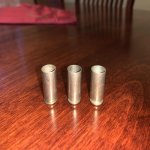I have a Lee Precision 4 hole turret press and would like to start reloading in .40 S&W. As for components, I have CamPro .40/10mm 165gr SH FCP bullets, TiteGroup powder, Federal small primers, and once fired mixed casings (Federal, Speer, Win).
If I plan to use my Lee auto-disk powder dispenser, the two sizes are .40cc & .43cc and they dispense 4.7 and 5.1 grains respectively. CamPro recommends 4.6-5.1gr of TiteGroup.
Is there anything wrong with my component selection and using 4.7 grains of powder?
If I plan to use my Lee auto-disk powder dispenser, the two sizes are .40cc & .43cc and they dispense 4.7 and 5.1 grains respectively. CamPro recommends 4.6-5.1gr of TiteGroup.
Is there anything wrong with my component selection and using 4.7 grains of powder?











































































